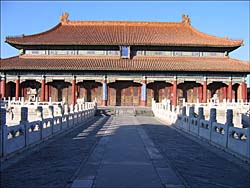
Unit 1: Redefining World Society and Culture
Lesson D: Life and Times in the Pre-Modern World
Lesson Overview

The Forbidden City [1]
"History" is full of names, dates, and wars, but these things do not help us understand how people in the past lived their daily lives. How did the art, religion, science, social structures, and political and economic systems shape past civilizations? How did these factors influence how individuals lived, worked, and played in history? How do we know what people in past civilizations valued? What types of buildings and artwork did people in the past create? How did rich and poor people live? In this lesson, we will explore key aspects that shaped the daily life of civilizations prior to the late 14th century.
Key Questions
- Why are some aspects of world civilizations, such as religion, social structure, and artistic achievements so long lasting and influential?
- How did people in the past live their daily lives?
- How did how people in the past lived their daily lives lay the foundation for our world today?
Student Outcomes
- Evaluate the role of gender, including inheritance laws, marriages, and legal status in societies such as those in western Europe, China, India, and the Middle East and Africa.
- Compare the political systems found in China, Japan, and Europe.
- Compare the artistic and architectural styles found in different societies, such as those found in classical Greece and Rome, the Byzantine Empire, the Tang and Song Dynasties, South and Southeast Asia, the Sudanic Empire, and different regions of the Americas.
- Identify the major scientific, mathematical, and technological achievements in different empires, such as the Gupta Empire, the Tang and Song Dynasties, and the Islamic Caliphates.
- Evaluate the impact of the fall of empires on the cultural and social aspects of life in different regions of the world.
- Draw comparisons across eras and regions in order to define enduring issues as well as large-scale or long-term developments that transcend regional and temporal boundaries. (Historical Thinking Skill)
Key Terms
- artistic
- culture
- daimyo
- dynastic cycle
- economic system
- feudalism
- figurehead
- intellectual
- Mandate of Heaven
- political system
- religion
- shogun
- social structure
- samurai
Student Resources
- Civilization Organization Chart (doc)
- Historical Investigation - Women in the Pre-Modern World (doc)
- Intellectual Achievements Jigsaw (pdf)
- Intellectual Achievements Jigsaw Organizer (doc)
- Impact of the Pre-Modern World BCR (doc)
Chart of Activities:
| Activities to Complete | Estimated Time |
|---|---|
| Pre-Assessment: Life and Times in the Pre-Modern World | 5 minutes |
| Key Term | 5 minutes |
| Activator: Life and Times in the Pre-Modern World | 5 minutes |
| Opening: PERSIA | 15 minutes |
| Activity 1: Analyzing Images | 15 minutes |
| Activity 2: Political, Economic, and Religious Aspects of Civilization | 5 minutes |
| Activity 3: China | 10 minutes |
| Activity 4: Western Europe | 10 minutes |
| Activity 5: Japan | 10 minutes |
| Activity 6: Civilization Knowledge Check | 5 minutes |
| Activity 7: Role of Women | 20 minutes |
| Activity 8: Intellectual and Technological Advancements | 25 minutes |
| Activity 9: Technology Knowledge Check | 5 minutes |
| Activity 10: Art and Architecture | 20 minutes |
| Activity 11: Art and Architecture Knowledge Check | 10 minutes |
| Activity 12: Putting Civilizations Together | 40 minutes |
| Review and Assessment | 25 minutes |
| Lesson Summary | 5 minutes |
Lesson Completion Time
The total estimated time to complete this lesson is 235 minutes.
Page Notes:
[1] This image from http://commons.wikimedia.org/wiki/File:BeijingForbiddenCity3.jpg is licensed with Creative Commons Attribution. Attribution: giladr.

